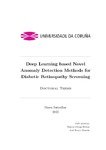Mostrar o rexistro simple do ítem
Deep Learning based Novel Anomaly Detection Methods for Diabetic Retinopathy Screening
| dc.contributor.advisor | Ortega Hortas, Marcos | |
| dc.contributor.advisor | Rouco, J. | |
| dc.contributor.author | Sutradhar, Shaon | |
| dc.date.accessioned | 2023-07-06T14:23:07Z | |
| dc.date.available | 2023-07-06T14:23:07Z | |
| dc.date.issued | 2023 | |
| dc.identifier.uri | http://hdl.handle.net/2183/33302 | |
| dc.description | Programa Oficial de Doutoramento en Computación. 5009V01 | es_ES |
| dc.description.abstract | [Abstract] Computer-Aided Screening (CAS) systems are getting popularity in disease diagnosis. Modern CAS systems exploit data driven machine learning algorithms including supervised and unsupervised methods. In medical imaging, annotating pathological samples are much harder and time consuming work than healthy samples. Therefore, there is always an abundance of healthy samples and scarcity of annotated and labelled pathological samples. Unsupervised anomaly detection algorithms can be implemented for the development of CAS system using the largely available healthy samples, especially when disease/nodisease decision is important for screening. This thesis proposes unsupervised machine learning methodologies for anomaly detection in retinal fundus images. A novel patchbased image reconstructor architecture for DR detection is presented, that addresses the shortcomings of standard autoencoders-based reconstructors. Furthermore, a full-size image based anomaly map generation methodology is presented, where the potential DR lesions can be visualized at the pixel-level. Afterwards, a novel methodology is proposed to extend the patch-based architecture to a fully-convolutional architecture for one-shot full-size image reconstruction. Finally, a novel methodology for supervised DR classification is proposed that utilizes the anomaly maps. | es_ES |
| dc.language.iso | eng | es_ES |
| dc.rights | Os titulares dos dereitos de propiedade intelectual autorizan a visualización do contido desta tese a través de Internet, así como a súa reproducción, gravación en soporte informático ou impresión para o seu uso privado e/ou con fins de estudo e de investigación. En nengún caso se permite o uso lucrativo deste documento. Estos dereitos afectan tanto ó resumo da tese como o seu contido Los titulares de los derechos de propiedad intelectual autorizan la visualización del contenido de esta tesis a través de Internet, así como su repoducción, grabación en soporte informático o impresión para su uso privado o con fines de investigación. En ningún caso se permite el uso lucrativo de este documento. Estos derechos afectan tanto al resumen de la tesis como a su contenido | es_ES |
| dc.rights | Atribución-NoComercial-SinDerivadas 4.0 Internacional (CC BY-NC-ND 4.0) | es_ES |
| dc.rights.uri | https://creativecommons.org/licenses/by-nc-nd/4.0/deed.es | * |
| dc.subject | Medicina-Informática | es_ES |
| dc.subject | Tratamiento de imágenes en medicina | es_ES |
| dc.subject | Diagnóstico por imagen | es_ES |
| dc.subject | Oftalmología-Informática | es_ES |
| dc.title | Deep Learning based Novel Anomaly Detection Methods for Diabetic Retinopathy Screening | es_ES |
| dc.type | info:eu-repo/semantics/doctoralThesis | es_ES |
| dc.rights.access | info:eu-repo/semantics/openAccess | es_ES |
Ficheiros no ítem
Este ítem aparece na(s) seguinte(s) colección(s)
-
Teses de doutoramento [2102]






